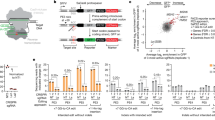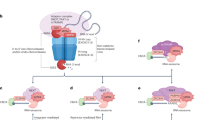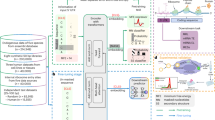Abstract
We have developed a protein-synthesizing system reconstituted from recombinant tagged protein factors purified to homogeneity. The system was able to produce protein at a rate of about 160 μg/ml/h in a batch mode without the need for any supplementary apparatus. The protein products were easily purified within 1 h using affinity chromatography to remove the tagged protein factors. Moreover, omission of a release factor allowed efficient incorporation of an unnatural amino acid using suppressor transfer RNA (tRNA).
This is a preview of subscription content, access via your institution
Access options
Subscribe to this journal
Receive 12 print issues and online access
$209.00 per year
only $17.42 per issue
Buy this article
- Purchase on Springer Link
- Instant access to full article PDF
Prices may be subject to local taxes which are calculated during checkout





Similar content being viewed by others
References
Stiege, W. & Erdmann, V.A. The potentials of the in vitro protein biosynthesis system. J. Biotechnol. 41, 81–90 (1995).
Jermutus, L., Ryabova, L.A. & Pluckthun, A. Recent advances in producing and selecting functional proteins by using cell-free translation. Curr. Opin. Biotechnol. 9, 534–548 (1998).
Kitaoka, Y., Nishimura, N. & Niwano, M. Cooperativity of stabilized mRNA and enhanced translation activity in the cell-free system. J. Biotechnol. 48, 1–8 (1996).
Matveev, S.V. et al. Effect of the ATP level on the overall protein biosynthesis rate in a wheat germ cell-free system. Biochim. Biophys. Acta 1293, 207–212 (1996).
Spirin, A.S., Baranov, V.I., Ryabova, L.A., Ovodov, S.Y. & Alakhov, Y.B. A continuous cell-free translation system capable of producing polypeptides in high yield. Science 242, 1162–1164 (1988).
Kim, D.M. & Choi, C.Y. A semicontinuous prokaryotic coupled transcription/translation system using a dialysis membrane. Biotechnol. Prog. 12, 645–649 (1996).
Kung, H.F. et al. DNA-directed in vitro synthesis of beta-galactosidase. Studies with purified factors. J. Biol. Chem. 252, 6889–6894 (1977).
Ganoza, M.C., Cunningham, C. & Green, R.M. Isolation and point of action of a factor from Escherichia coli required to reconstruct translation. Proc. Natl. Acad. Sci. USA 82, 1648–1652 (1985).
Pavlov, M.Y. & Ehrenberg, M. Rate of translation of natural mRNAs in an optimized in vitro system. Arch. Biochem. Biophys. 328, 9–16 (1996).
Pavlov, M.Y., Freistroffer, D.V., Heurgue-Hamard, V., Buckingham, R.H. & Ehrenberg, M. Release factor RF3 abolishes competition between release factor RF1 and ribosome recycling factor (RRF) for a ribosome binding site. J. Mol. Biol. 273, 389–401 (1997).
Guillon, J.M., Mechulam, Y., Schmitter, J.M., Blanquet, S. & Fayat, G. Disruption of the gene for Met-tRNA(fMet) formyltransferase severely impairs growth of Escherichia coli. J. Bacteriol. 174, 4294–4301 (1992).
Benne, R., Arentzen, R. & Voorma, H.O. The mechanism of action of inititation factor F1 from Escherichia coli. Biochim. Biophys. Acta 269, 304–310 (1972).
Atkinson, D.E. The energy charge of the adenylate pool as a regulatory parameter. Interaction with feedback modifiers. Biochemistry 7, 4030–4034 (1968).
Noren, C.J., Anthony-Cahill, S.J., Griffith, M.C. & Schultz, P.G. A general method for site-specific incorporation of unnatural amino acids into proteins. Science 244, 182–188 (1989).
Kim, D.M., Kigawa, T., Choi, C.Y. & Yokoyama, S. A highly efficient cell-free protein synthesis system from Escherichia coli. Eur. J. Biochem. 239, 881–886 (1996).
Glick, B.R. & Ganoza, M.C. Identification of a soluble protein that stimulates peptide bond synthesis. Proc. Natl. Acad. Sci. USA 72, 4257–4260 (1975).
Kossel, H. Purification and properties of peptidyl-tRNA hydrolase from Escherichia coli. Biochim. Biophys. Acta 204, 191–202 (1970).
Lu, J., Aoki, H. & Ganoza, M.C. Molecular characterization of a prokaryotic translation factor homologous to the eukaryotic initiation factor eIF4A. Int. J. Biochem. Cell. Biol. 31, 215–229 (1999).
Spedding, G. Isolation and analysis of ribosomes from prokaryotes, eukaryotes and organelles. In Ribosomes and protein synthesis: a practical approach. (ed. Spedding, G.) 1–29 (IRL Press at Oxford University Press, New York, NY; 1990).
Olins, P.O. & Rangwala, S.H. A novel sequence element derived from bacteriophage T7 mRNA acts as an enhancer of translation of the lacZ gene in Escherichia coli. J. Biol. Chem. 264, 16973–16976 (1989).
Sampson, J.R. & Uhlenbeck, O.C. Biochemical and physical characterization of an unmodified yeast phenylalanine transfer RNA transcribed in vitro. Proc. Natl. Acad. Sci. USA 85, 1033–1037 (1988).
Jelenc, P.C. & Kurland, C.G. Nucleoside triphosphate regeneration decreases the frequency of translation errors. Proc. Natl. Acad. Sci. USA 76, 3174–3178 (1979).
Wagner, E.G., Jelenc, P.C., Ehrenberg, M. & Kurland, C.G. Rate of elongation of polyphenylalanine in vitro. Eur. J. Biochem. 122, 193–197 (1982).
Poe, M., Greenfield, N.J., Hirshfield, J.M., Williams, M.N. & Hoogsteen, K. Dihydrofolate reductase. Purification and characterization of the enzyme from an amethopterin-resistant mutant of Escherichia coli. Biochemistry 11, 1023–1030 (1972).
Schleif, R.F. l-arabinose operon messenger of Escherichia coli. Its inducibility and translation efficiency relative to lactose operon messenger. J. Mol. Biol. 61, 275–279 (1971).
Short, G.F., Golovine, S.Y. & Hecht, S.M. Effect of release factor 1 on in vitro protein translation and the elaboration of protein containing unnatural amino acids. Biochemistry 38, 8808–8819 (1999).
Acknowledgements
We thank S. Yokoyama, The University of Tokyo, for providing the expression plasmid encoding the ArgRS gene. This work was supported by a grant (JSPS-RFTF 96100306) from The Japan Society for the Promotion of Science (to T.U.).
Author information
Authors and Affiliations
Additional information
The online version of the original article can be found at 10.1038/90773
Electronic supplementary material
Rights and permissions
About this article
Cite this article
Shimizu, Y., Inoue, A., Tomari, Y. et al. Cell-free translation reconstituted with purified components. Nat Biotechnol 19, 751–755 (2001). https://doi.org/10.1038/90802
Received:
Accepted:
Published:
Issue Date:
DOI: https://doi.org/10.1038/90802
This article is cited by
-
Development and optimization of a modular two-fragment LacI switch for enhanced biosensor applications
Biotechnology and Bioprocess Engineering (2024)
-
Efficient recombinant production of mouse-derived cryptdin family peptides by a novel facilitation strategy for inclusion body formation
Microbial Cell Factories (2023)
-
T7Max transcription system
Journal of Biological Engineering (2023)
-
Rapid discovery of high-affinity antibodies via massively parallel sequencing, ribosome display and affinity screening
Nature Biomedical Engineering (2023)
-
Accessible light-controlled knockdown of cell-free protein synthesis using phosphorothioate-caged antisense oligonucleotides
Communications Chemistry (2023)



